Marijuana Cloning FAQ - Become an Expert
Cloning marijuana plants are a great way to kickstart your next grow, by saving money on seeds and preserving the genetics of the strains you are currently growing, including their gender. This means that cloning your marijuana plants can be a way to save money of feminized seeds, while still ensuring you do not have any male plants in your growing area.
When you clone marijuana plants, they remain the same age as the mother plant - and are much more mature than seedlings. Once your clones take root, they will grow much quicker than from seed - but this is only true if the cloning process is done correctly, keeping the plant in good health.
People often see merit in re-creating a harvest of their best performing plants. When you have found a strain that you really enjoyed, having clones available to keep it going for the next grow just makes sense. Moreover, you are recreating it's yield, flavor, bud characteristics and growing time - not to mention, cloning a plant is ultimately cheaper than buying new seeds and saves you time and effort in dedicating time to the germination process.
Under the right environmental and grow conditions, it is entirely possible to have a completely self-sufficient garden. Imagine re-creating the phenotype of your best plant for as many harvests as you want without ever having to buy new seeds.
We have put together an all inclusive marijuana cloning guide which will detail the process of taking the best marijuana clones, keep them in good health, and explain how to get your clones to root quickly. Below we'll start with the basics and preparation steps, and explain everything you need to know about clones, before moving onto maintaining the clones while they take root.
Before we get started, we wanted to share some pictures of our demonstration regarding the proper treatment of your cannabis clones. In the first picture, we can see that the clone has successfully rooted, and has been transplanted. Although the plant has survived, it is visibly wilted and has a prominent discoloring throughout it's leaves. This is a sign that it has undergone significant stress before it was able to grow it's roots, and will now take time to recover.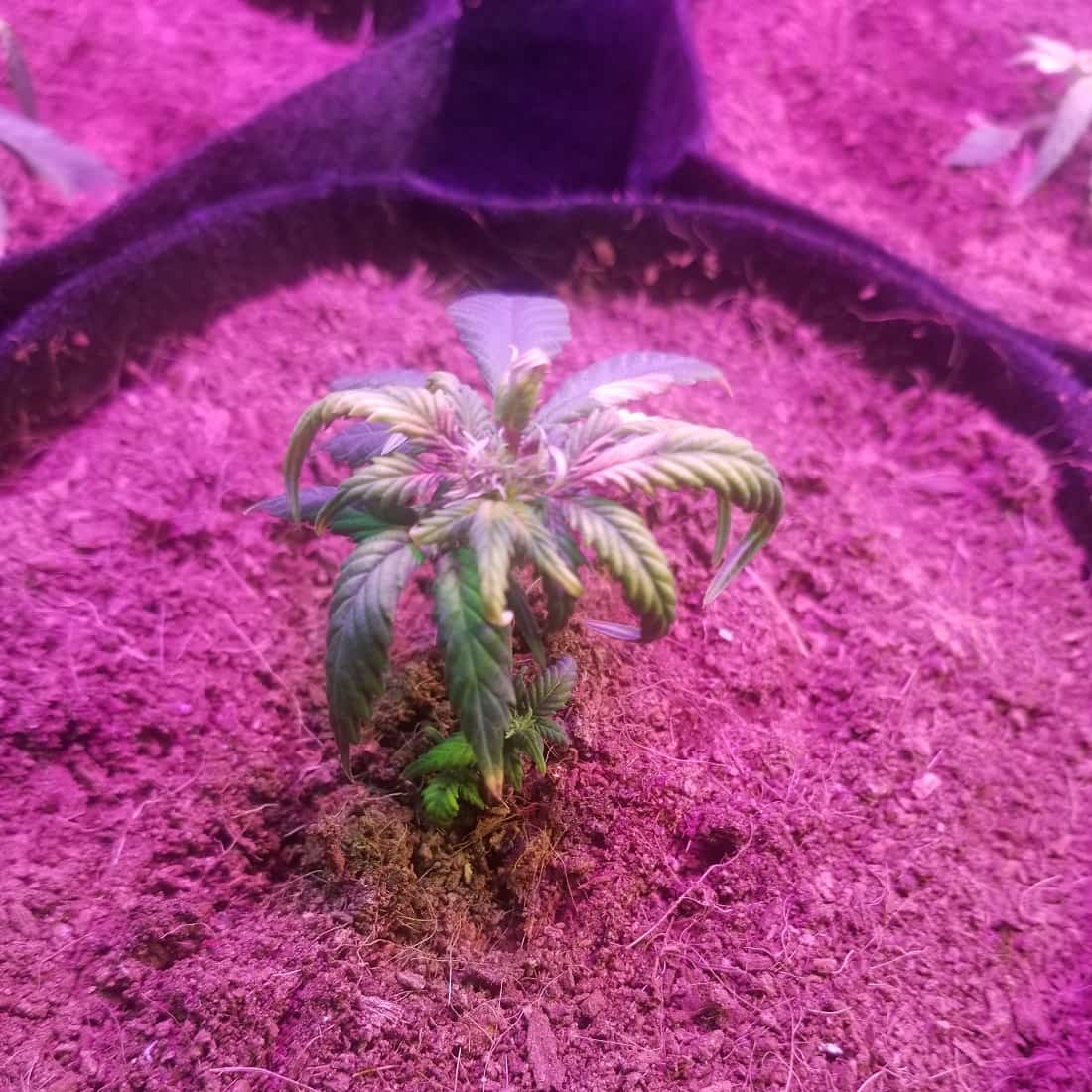
In the next image, we can see our second clone which was subject to much better treatment. This clone has no visible issues, and was able to begin growing roots before it experienced dehydration. For the next few weeks, this clone will begin growing much faster than the first clone, due to it's good health.
Both of these clones were taken from the same plant, and region. The healthier clone was ready to be transplanted less than 24 hours after the stressed out plant. The only difference between them was the environment in which they were kept, and the processes used.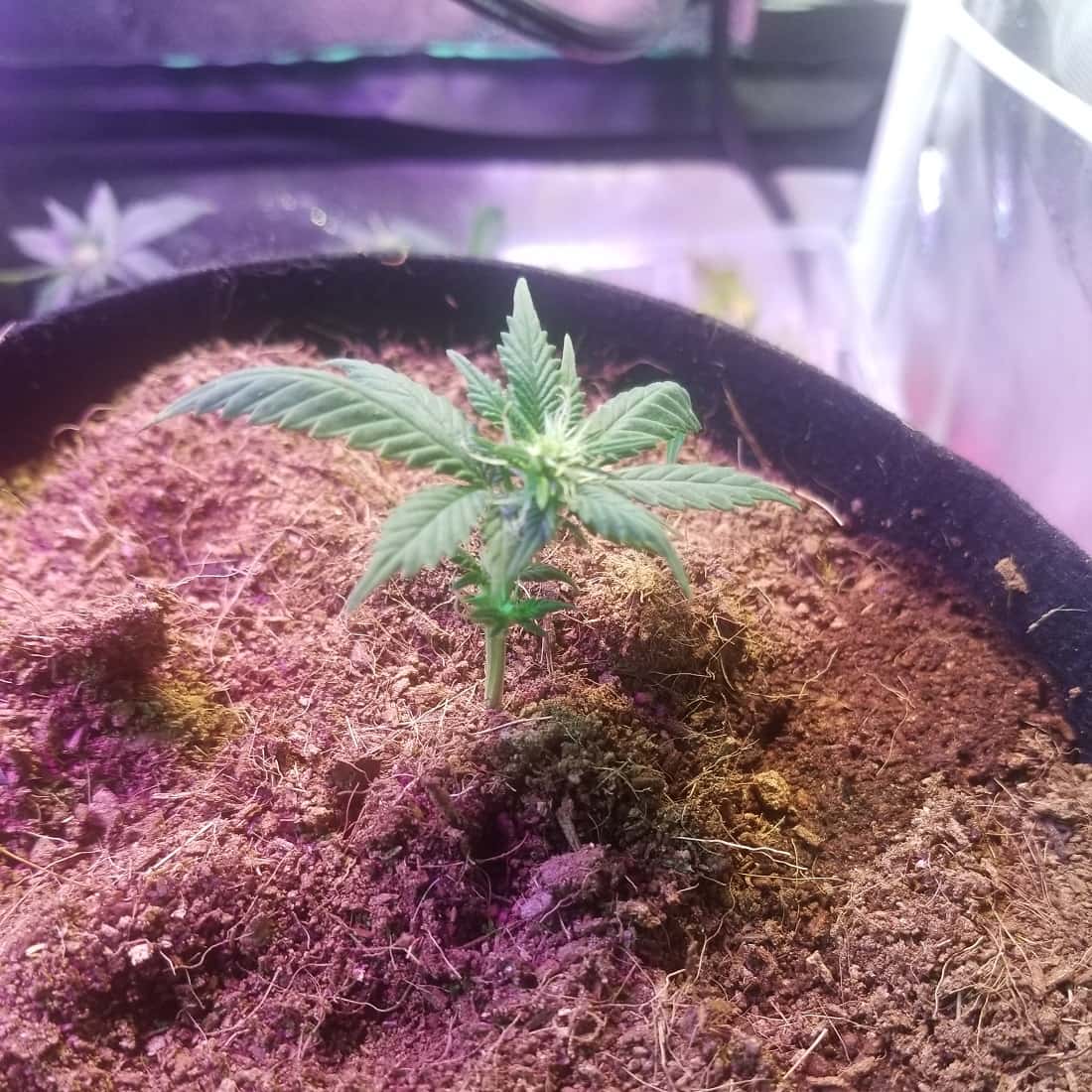
What are Marijuana Clones?
A marijuana clone is simply a cutting from a vegetative or flowering marijuana plant - which becomes the "mother". When placed into the proper environment, the cutting will begin to grow roots and can be treated as a new marijuana plant - an exact replica of the mother.
Although you can use any stem or branch as a clone, there are a number of things to take into consideration in order to ensure you are taking the best clones, and able to keep them healthy while they begin to root.
Choosing a Marijuana Plant to Clone From
When you are cloning marijuana plants, you will be preserving all of the traits from the mother plants. When done properly, this will allow you to continue using the plant's genotype which features your desired properties.
However, as it is an exact replica of the mother - any sickness or problems will also be inherited by the clone. For this reason, you should always look to take clones from a healthy mother plant.
What Branches are best for Marijuana Clones?
When you are taking marijuana clones from a mother plant, you will want to have a preference for cuttings which come from the lower branches. The branches from the lower regions of the plant will feature higher amounts of the hormones responsible for establishing roots - this factor can be a benefit for those who are using the SCROG method for growing, where all of the lower growth is removed.
If necessary, cuttings taken from higher area of the plant can still be used as clones, but they will have a reduced survival rate, and will not grow roots as quickly. One disadvantage of taking clones from higher up on the plant is that, unless the plant is a dedicated mother, you will have reduced some of your higher quality yield - whereas the removal of lower branches will have only cost a few popcorn sized buds.
How to Clone Marijuana Plants
Two plant reproduction types
Sexual - Possibly the most common to occur in nature without human intervention. Sexual reproduction occurs when a female plant is cross pollinated with a male plant to create seeds. With human intervention, having control over the pollination process allows you to create your desired hybrids. This is how most hybrids came to be.
Asexual - typically the method referred to when talking about cloning. A clone is born when a portion of a plant is cut and planted to grow roots of it's own. Thus, giving it exact characteristics of its parent plant. The asexual reproduction method is popular for both large and small scale operations. When you have optimized your cloning process, your garden will be both cost-effective and self-sustaining.
As we mentioned earlier, asexual cloning is a process where cuttings, taken from the crop you wish to clone, are re-planted. Thus, allowing it to grow roots and become it's own entity. Usually cuttings are taken from sturdy lower branches of its mother. Before beginning the cutting process. You'll want to take the time to cover a few necessary precautions that should be taken to ensure a successful cloning process.
Thinking about cleanliness is key. That is to say, before tinkering with your crops, always keep in mind you should be working in a sterile environment with sterile tools. We do this to mitigate any risks of agitating our plants and the cuttings with contaminates and mishandling.
Avoid fertilizing your plants in the days leading up to the cloning process. By doing so you, you will encourage an excess of nitrogen to the plant's extremities. Having a healthy amount of nitrogen in your cuttings will instruct the clone to focus its energy towards growing vegetation rather than rooting.
Find a parent crop with healthy characteristics. Keep in mind it's strength, resilience, general health and progression into its vegetation cycle. For best results use a plant at least two months into its vegetation cycle. Otherwise, three weeks should be the minimum before you take your first cut.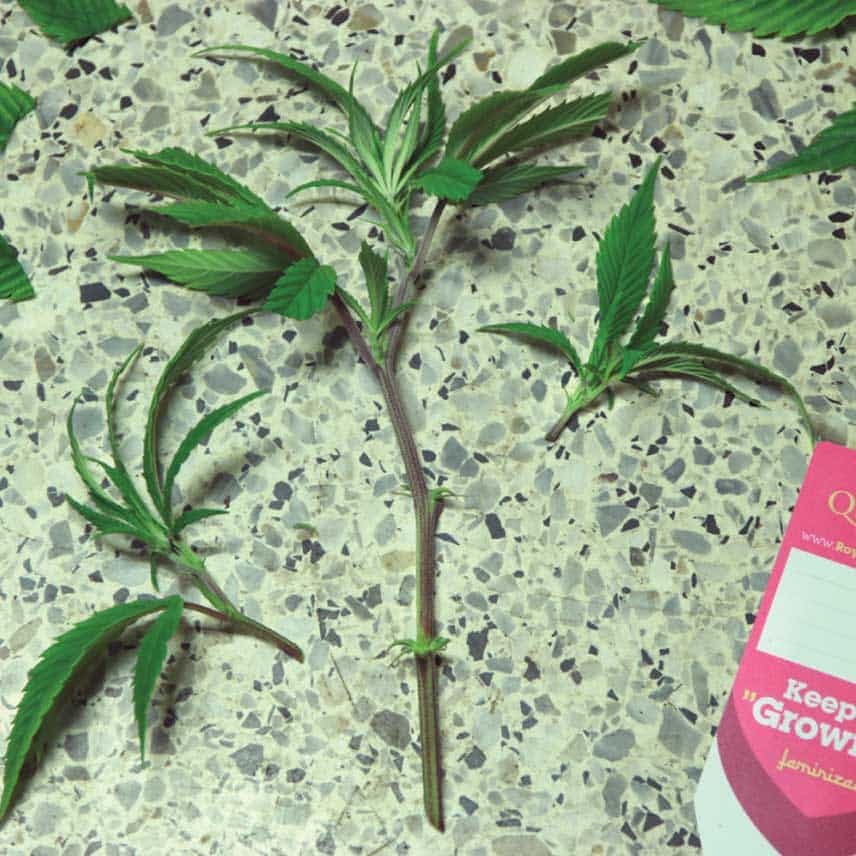
Take healthy cuttings from the mother plant. As we stated before, you will want to look for healthy and sturdy lower branches to plant. Depending on your rooting medium, you will want the cuttings to fit comfortable in their new home. For example, if you're using rockwool, the diameter of the insertion hole should be the same as the diameter of the sample stem. Otherwise, we suggest an 8-10" cut of a stem with a good amount of nodes.
Cut as close as you can to the parent's main stem, using a clean razor, at a 45° angle. It is good practice to ensure your clone's main stem is as sturdy as possible. As well, increasing the stem diameter for the clone allows it to have better rooting space and ensures a healthy grow.
Use clean water. Unfortunately, tap water won't do. Just like during your germination process, we want to avoid exposing a vulnerable plant to contaminates. Ensure the water is rich with the nutrients your plant needs. Once you have your cuttings, you're going to place them into water to prevent air bubbles in the stem. Do this relatively quickly, so air doesn't block water from being absorbed into the stem. After all, water is where your clone will begin to root. Note, some growers make multiple cuts into the stem before placing it into water. The reasoning dictates it promotes root growth.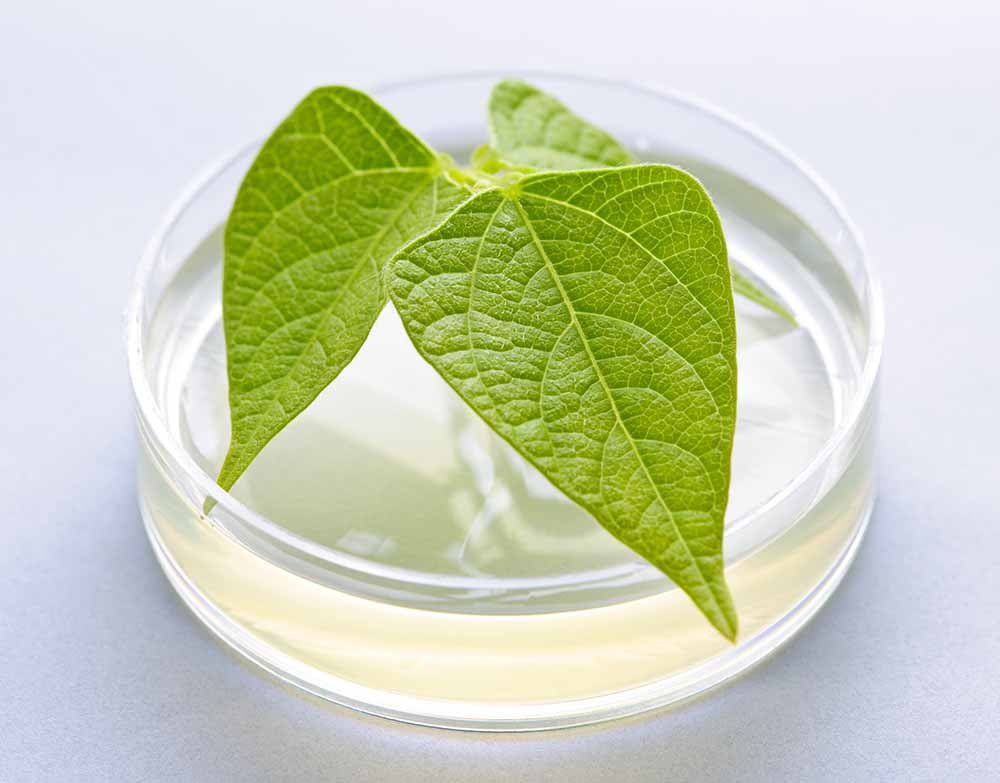
Remove extra leaves from the cuttings. Once your cuttings have been placed in water, use scissors to clip off fan leaves. This will encourage photosynthesis to take place as well as creating a clean environment for the clipping's rooting to occur. Work your way from halfway down the clone's stem. Make sure there aren't any extra leaves towards the bottom of the stem that may interfere with the growing medium. For sanitary reasons, it's good to keep the growing medium as undisturbed by extra foliage as possible. As well, manicuring will better assist your clones in absorbing nutrients.
Once the rooting stage has begun, you may want to consider using a growing hormone to promote healthier and faster root growth. There are many options available. Gels, powders and other hormone variants are usually available for purchase at local gardening or hydroponic retailers. If you decide to take this route, it will only require giving the clone a quick dip before it rests in its final rooting medium.
Choosing a rooting medium
We believe non-soil rooting methods are the best choice for a rooting medium. For example,
rockwool cubes provide favorable conditions for a clone to develop in for their airflow properties and ability to retain moisture. Rockwool cubes or similar products can be found online or at gardening stores.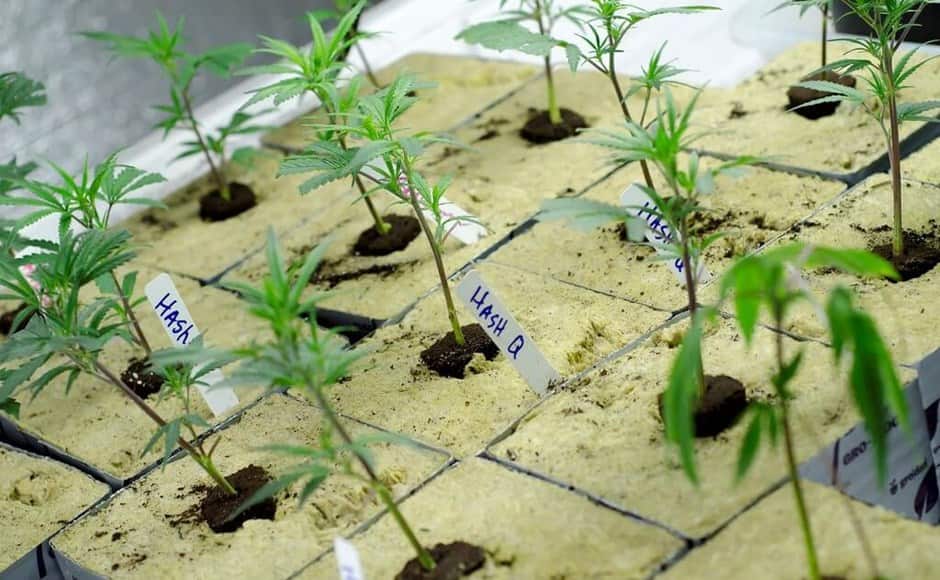
If you decide to root in soil, make sure the soil you use does not have an abundance of nutrients. It's also important not to over or under water the soil before transplanting your clone into it.
Rooting in water is the simplest form of a rooting medium. It does not require the use of rooting hormones or any sophisticated practice. Simply leave your clipping in water until they begin to develop roots.
an auto-cloner is an automated system designed to provide your clones with the appropriate and humidity for their growing stages. Auto-cloners take much of the guessing work out for you but can be large and expensive depending on your needs.
Each method has its benefits and downfalls. It's best to experiment take notes and decide which method works for your preferences. In any case, allow your clones at least 18hrs of light and humidity.
Transplanting the clone
Once you see vegetation begin to grow on your clones you will know it is time to transplant. All that is required is to move the clone into a larger growing space.It's important to take care and to be sanitary anytime you are working with transplanting crops. Transplant shock occurs when a plant has been agitated. It's usually due to unsanitary transplanting methods. It is a common occurrence so allow yourself the time and resource to create a safe transplanting environment.
Cloning your plants isn't an overly difficult process and doesn't require a lot of technical skill. There are many reasons why one might opt into cloning plants. It's efficient, easy and it saves time and money. Cloning is a great way to develop a self-sufficient garden and it allows you to recreate a good harvest over and over again. We hope you found this article on how to clone a plant helpful and informative. Be sure to practice good cloning practice and hone your skill over time.
When to Cut Marijuana Clones?
Clones can be taken off any healthy vegetative plant - however, if it's a very young want to be cautious as to not over stress the plant. Make sure it has not had any traumatic experiences recently, such as being transplanted or dehydrated.
When you take cuttings from a mother plant, it will need a few days to recover, proportionate to the amount which was removed. During this time you will want to avoid taking further cuttings.
What is Monster Cropping?
The term monster cropping refers to the act of taking marijuana clones from a mother plant which has entered the flowering cycle. Typically, marijuana clones are taken from a vegetative mother plant. However, you can also take clones from a plant which has already entered the flowering stage - though this is best done during the first few weeks. When these monster cropped clones are placed under at least 18 hours of light, they will revert back into a vegetative state.
Clones taken from a flowering plant will often root at a slower rate than clones taken from a vegatative mother plant, and this is due to the flower-related hormones within the plant. Since these clones will root slower, it is important that you prepare to maintain their health for an additional few days compared to usual clones. It is these flowering hormones which are the desired result from performing the monster cropping technique: though these "mixed signals" can initially lead to various mutations within your clone. Once the growth of your monster cropped clone has settled down, you will notice it grows much bushier and more vigourously than a normal clone.
While you can treat monster cropped clones like any other (slow rooting) clone, they should be observed much more carefully. This is because of the stress placed on them during the transition back into the vegatative state during the rooting process. When a plant receives too much stress, it can become a hermaphrodite (simultaneously male and female), which will lead to the production of seeds within your garden - even if your garden only consists of a single plant.
What Size Should Clones Be?
The ideal size of a marijuana clone is between 3 to 5 inches. This is comfortable enough to fit inside most greenhouse domes, as well as allowing it be firmly seated inside the rooting medium.
The real answer will depend on your environment, and tools you will be using to help promote root growth - cuttings of almost any size can be made into clones.
What do I need to take a Clone?
The following items are helpful to have on hand when you are preparing to take some marijuana clones:
- Sterile Razor Blade / Scissors
This will prevent infections to both the clone, and the mother plant. - Rooting Medium
You will need something to place the clone into, while it begins to root. - Humidity dome
This will help you to keep humidity levels high. - Hygrometer
This will help you to monitor temperature and humidity levels. - Optional Rooting Hormones (Gel or Powder)
These products are used to encourage the developments of roots - they can help to increase survival rates, and reduce the time necessary for clones to successfully root. - Optional Seedling Heating Mat
This is used to ensure the rooting medium stays at a temperature which promotes the root growth.
What is the Best Rooting Medium for Clones?
There are a number of options available to use as a rooting medium for your marijuana clones - such as soil, peat pellets, and rock wool cubes. There are also proprietary variations of these mediums, such as the Rapid Rooter starter plugs.
Each of these rooting mediums has different properties - you should choose one which best suits your needs. We'll describe them for you below:
Soil (or Directly into a Pot)
Using soil as a rooting medium for your clone will be the easiest solution, but the simplicity does come with some disadvantages. It will be much harder to keep the moisture levels surrounding the cutting, at an ideal level without over watering.
One potential advantage of using soil is the insulation it can provide for growers in cooler areas. By using a larger amount of soil and a container, you will protect the roots from lower ambient temperatures which will reduce the speed of growth.
When using soil as your rooting medium, it should be watered sparingly just prior to inserting your clone.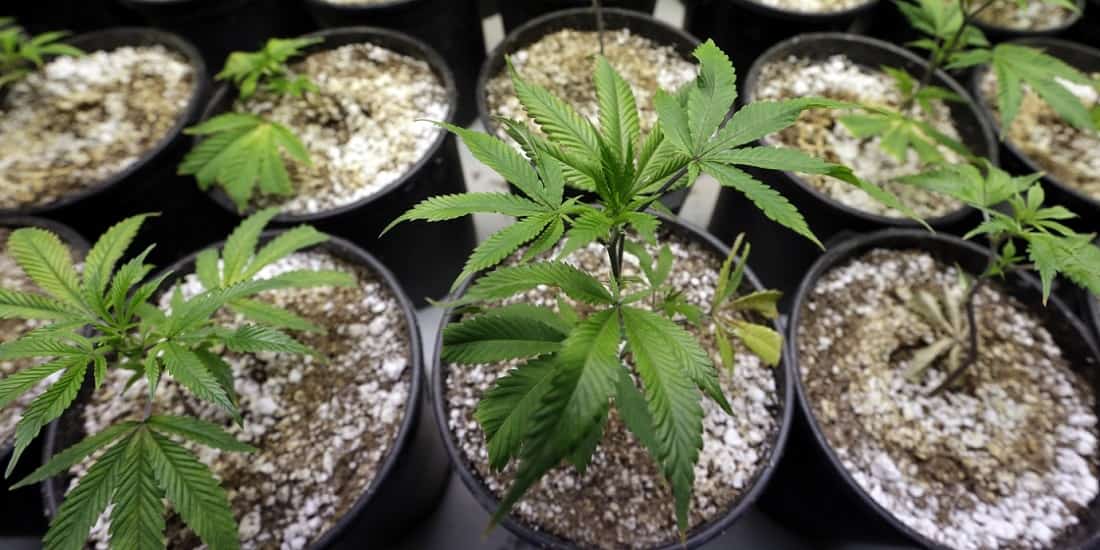
Peat Pellets
A cheap rooting medium, peat pellets will provide your cutting with everything it needs to begin growing it's first set of roots. The peat pellets will stay moist, and provide an ability to remove excess water.
We recommend the use of a seedling mat due to the peat pellets small size -the moisture and contact with a cold foundation/floor will reduce the temperatures and stall the growth of roots.
Rock Wool Cubes
Another cheap rooting medium, Rock Wool cubes are essentially blocks of insulation (fiberglass) for your cutting to be seated into.
While rock wool cubes do not suffer from the same temperature concerns as peat pellets, they have even bigger concerns - which is mold. Due to the necessity of keeping the rooting medium moist and accompanied humidity dome, the rock wool cubes become an ideal environment for mold to begin growing on.
Finally, if you are using rock wool for your clones it will be important to soak them in water which has been properly brought to a PH level of 5.8 - this will ensure they are at adequate levels, and prevent shock to your plant.
Do I need a Humidity Dome for Clones?
The use of a humidity dome will greatly increase the change of your plants surviving until they have the chance to grow roots. A new marijuana clone will not have established roots, and will be reliant on humidity levels in order to maintain water intake.
Depending on your growing environment, your natural humidity levels may be around 25 - 40%. These humidity levels are much too low for marijuana clones to maintain their water, which will cause the leaves to begin to wilt. Clones which remain in low humidity environments will continue wilting, and eventually die to lack of water.
The use of a humidity dome will allow you to contain moisture within a confined area, and reach the desired 70 - 100% humidity levels required for marijuana clones. Through maintaining proper humidity levels, you will be able to keep the clones alive and healthy while they begin the process of forming their first roots. While a humidity dome itself may not be required, it is critical that you are able to keep moisture in the air.
If you do choose to use a humidity dome for your marijuana clones, it is a good idea to remove the dome periodically in order to allow fresh air to enter. If you skip this step, you will be encouraging the growth of mold, and may lead to suffocation of your plants.
P.s. Keep reading further along in our cloning FAQ, to learn how to avoid perspiration within your clones - increasing their chances of survival, but also allowing them to stay alive with reduced humidity levels. We also talk about what happens if your humidity is too high, and tricks on how you can use your humidity dome to help your clones root faster.
Which Rooting Hormones to Use?
Using a number of ingredients, rooting gels and powders are used to help promote the hormones responsible for the growth of roots. There are a number of different brands, and variations of application. In our experience, the best product varies from strain to strain - we have tried to perform many experiments, without any conclusive results.
Fortunately most of the rooting hormone products for cannabis are not that expensive. While their effectiveness could be argued, you may as well apply one to your clones for the sake of a few dollars - some users will even use multiple products on a single clone, to take advantage of both power and gel applications.
How to Cut Marijuana Clones
When you have assembled your supplies, take your sterile scissors and cut the chosen branch from the marijuana plant. You should aim for a close cut, and avoid leaving a broken stem/branch on the mother plant. When you have separated the cutting from the mother plant, you will want to sterilize your scissors - and prepare to make a second cut to the clone.
This time, you should cut at a 45 degree angle. If the clone is already within the ideal size of 3 to 5 inches, you will not need to remove much more of the stem with your second cut. Once your rooting hormones have been applied, promptly insert the clone into your rooting medium and ensure that it is firmly seated.
If you are using a rooting hormone, apply it to your clone into it immediately after making the second cut. Be sure to follow the the instructions from the manufacturer - although application typically consists of simply covering a quarter inch of the stem with their product.
You can now place the newly planted clone under a light. be sure to monitor humidity levels, and moisture of the rooting mediums. If you find that the rooting medium is losing moisture, you can apply a small amount of room temperature water to the rooting medium.
If the humidity levels are dropping, you can spray the humidity dome or surrounding area with a spray bottle. Tip: Be sure that you are using RO water with a proper PH level of 5.8 during these processes to prevent any shock to your plant, or build-up within your rooting medium.
Cutting Marijuana Clones Submerged Underwater
There are concerns that by making a cut into the plant, there are possibilities of oxygen entering the vascular system of the plant which can lead to the prevent of moisture intake.
In order to alleviate this concern, you can submerge your clone under water when making your second cut - which will create a brief seal against oxygen, as you complete the rest of the cloning process.
If your time allows or the circumstance requires it, cutting your clones at the 45 degree angle while they are submerged underwater will not hurt the clone, and could improve the survival rates of your clones. In our experience, our rate of surates have been high enough not to warrant this extra step.
Removing Leaves from Marijuana Clone
The purpose of removing leaves from your clone is to help avoid perspiration which will lead to your plant becoming dehydrated. Since your clone will not have roots for several days, it is important that they are able to maintain healthy water levels.
Leaves are one of the biggest ways in which water escapes the plant. By removing all unnecessary branches and leaves, we will help to ensure the clones survival and prevent the stress of dehydration.
The removal of leaves consists of all leaves and branches up to the top of the clone. A select few leaves must be left alone, to allow the process of photosynthesis to occur.
When to Water Marijuana Clones?
Initially it will only be necessary to keep the rooting medium moist. After the first few days you will want to begin administering small amounts of water around the rooting area. It is ideal to place water further away from the roots, driving them to reach for it - but be sure that the primary rooting area still remains wet. Depending on your environments humidity level and temperature, you may need to monitor your clones more closely for signs that they need water.
When you are watering your marijuana clones, you should be using water which has been brought to a PH level of around 5.8 (small fluctuations are OK). Until the roots have been established, you will want to avoid using any nutrients and instead stick with regular RO water. Finally, the water should be brought to room temperature to prevent any shock to the plant, and ensuring the temperatures of the rooting medium stay within an ideal range for promoting root growth.
What Light to Use for Clones?
Marijuana clones do not require notable amounts of light, until they have rooted and entered the vegetative state. Therefore the best light for your clones is one which can be placed far away from the plants.
Providing too much light will delay the rooting process, and decrease the rate of survival. It is ideal to place your light as far away from the plants as possible, because we want the plant to be inspired to reach for more light. This is similar to our trick on slowly reducing humidity in order to root clones faster (described further on).
In order for the plant to access more light, your clone will knows it needs to grow and reach toward the light - which requires a root system. If you are providing the clone with significant amounts of lighting, it will not have a need to begin growing roots.
When your clone begins to grow roots or has been transplanted, the light can slowly be brought closer to the plants over a period of time. It should be done slowly, to avoid shocking or burning the plant. Furthermore, the plant is only capable of handling so much light in it's infancy - you should try to lower the light at a comparable speed to the plants ability to utilize it.
The best light for your marijuana clones will depend on your environment. If you benefit from increased heat, a T5 bulb will be helpful. CFL (compact fluorescent lamp) bulbs are also acceptable and available at most hardware and grocery stores. See our next question for picking the best bulb(s) for promoting growth and rooting your clones faster.
What Color Light Spectrum is Best for Clones?
Either Blue or Red spectrum will work for marijuana clones and studies report them both being equally potent at promoting the growth of healthy roots. Both blue and red light spectrum have a comparable advantage over other colors.
For red spectrum for clones, we recommend the 2700k color, often made available under the name of "Warm White". This color of bulb will promote root growth - but should be discontinued after the clones have successfully taken roots.
For blue light spectrum for clones, we recommend anything within the color range of 5000k to 6500k. Both 5000k and 6500k bulbs are readily accessible at most stores, and sold under the name of "Daylight" bulbs.
Although both red and blue light spectrum are beneficial for the development of roots, the blue color spectrum is more desirable during the vegetative state that your clone will enter once it has taken roots. For this reason, it may be better for most users to use a blue light color in case they have their clones become ready for transplanting at different times.
What Light Schedule for Cannabis Clones?
In many cases, it is simpler to leave the lights on 24 hours, until the clone is ready to be transplanted. The primary reason for this is to ensure that the temperatures do not fluctuate, keeping the rooting medium at an ideal temperature. The darkness accompanied with the moisture from your rooting medium is also an environment that encourages the growth of mold.
While 24 hours of lighting is not ideal for power consumption - you will hopefully be using a low wattage bulb for your clones, and the actual cost should be negligible. If you are turning your light off to save power, you must have at least 18 hours of light in order to maintain the vegetative state of the clone. This is especially true for "monster cropping", or clones taken from a flowering mother plant, which must revert from the 12 and 12 flowering cycle.
Is Night Cycle Needed for Clones?
The light cycle and and associated phytochrome system are used to determine the length of each day, and determine how close the plant is to flowering time. In the case of our clones, all we really care about is their progress of growing roots which is necessary for their survival.
If you do choose to turn off the light for a dark period and allow a recovery period for your clones, we recommend a twice daily schedule. Plants use the dark period to perform a series of chemical reactions, using the light they have stored during the day. Clones will have minimal leaves, and can complete their necessary processes much quicker than a full plant.
Here is a simplistic explanation on which we base our recommendation for the twice a day night cycle for clones, if you are absolutely adamant about turning your light off at all:
By turning the light off twice a day, you will be allowing your clones' phytochrome system processes to occur and start converting the "pfr" accumulated within the chromoproteins and turns them into into "pr". This only happens during the night cycle, and when light reaches the chromoprotein the process reverses and all "pr" convert back to "pfr". However, because your clone cannot store as much "pr", they do not require an extensive period of darkness to accomplish this function.
What Temperature is best for Clones?
The ideal temperature for promoting the growth of roots, and ensuring the plants remain healthy is 22 to 23 degrees for both the rooting medium, and the tops of the plant. If the temperatures are too low, development of the plant and it's roots will begin to slow - and can eventually lead to death, especially if your clones have not developed their first few roots.
If the temperature is too high, your marijuana clones can experience heat stress just like any other plant. This will cause them to close their stomatas, and prevent the exchange of gases - slowing productivity of the plant, and cause your clones to take longer before they are ready to be transplanted. Furthermore, a high temperature will encourage the development of mold within your most rooting medium, which can quickly derail your gardening plans.
What Humidity is best for Clones?
Since new clones will not have roots in which to intake water and remain hydrated, they will use their leaves to draw in moisture from the air. In order to prevent the stress of dehydration, it is important to keep your humidity levels in the 90 - 100% range which will allow them as much moisture as they require. Lower humidity levels are acceptable, but will reduce the chance of survival.
After a few days, you should begin to reduce the humidity levels gradually, which will inspire root growth, while still ensuring the plant is able to remain hydrated. If you are noticing rapid wilting, that means the clones have experienced uncomfortably low humidity levels and that they should be increased.
How Long Do Marijuana Clones Take to Root?
You can expect clones to begin taking root within a period of 7 to 14 days. The actual period time that is required will depend on a number of factors which are described below
Mother Plant
The health of the plant from which the clone was taken will determine how quickly the clone is able (or needs) to begin growing roots. If the mother plant was unhealthy, the clone will not have all of the nutrients and resources necessary to produce healthy roots quickly, or in extreme cases, failure to root at all.
On the other hand, if the mother is too healthy and well watered, the clone will continue to have everything it needs for several days. This would increase the time required for the clone to begin generating roots, but does ensure that the clone remains in good health during the process.
In other words, clones taken from a healthy mother plant will have a higher chance of survival and will ultimately be healthier. However, they will not have under as much duress and will not be stressed to grow roots as quickly.
Temperature
The temperature of your environment should be within healthy ranges for to encourage optimal growth. If the area is too cold, growth will be delayed and may stop entirely. If the area is too hot, the plant will become stressed leading to the stomatas of the plant leaves may close and prevent gas exchanges - impacting photosynthesis. Temperatures should be kept under 28 degrees to prevent this from happening.
Humidity
Earlier in our marijuana cloning FAQ we discussed what happens when your clones do not receive high enough humidity levels. Low humidity levels will lead to wilting, and the eventual death of the marijuana clone.
However if the clones are sufficiently healthy and receive too much humidity, they will not have any incentive to grow roots and will take longer to do so. If you are using a humidity dome, you should be periodically removing it to allow for fresh air. To encourage root growth, you can begin leaving the dome off for extended periods of time, before removing it entirely.
While patience is almost always helpful, this may not be true when it comes to dealing with your new clones. Without roots, your plant is not able to perform critical functions and while it can survive for an extended period of time - and even grow new roots - it can only go so long without roots.
In other words, there is a fine line between keeping your clones healthy and providing them with incentive to grow new roots by lowering the humidity levels gradually. Refering back to our experiment at the beginning of this FAQ, we noted that the healthier clone took approximately 24 hours longer than the stressed out clone.
Marijuana Strain and Plant Genotype
With over 2,800 marijuana strains our library, it's important to understand that all marijuana plants have individual characteristic, and even plants within that same strain or lineage.
Marijuana grows all over the world, and in many different environments. The strains of marijuana which grow in hot and sandy areas are under much more pressure to root quickly, than strains which originated from humid and tropical environments. Learn more about the strain you are growing, to better understand the environment in which it's genetics prefer.
Finally, when you have identified a strain which tends to root quickly when cloned, it is important to consider the individual genotype of the mother plant which may be providing this attribute, and not the strain. It is possible that you will have a plant which is better for producing clones than another.
CO2 Supplementation.
While many of us already know the benefits of CO2 within our garden, it is often overlooked when it comes to cloning marijuana plants. Studies have shown that elevated levels of CO2 promote growth in a number of different ways, including increased number of shoots as well as larger surface area, diameter and volume.
The study also notes the improved nutrient uptake as a result of CO2 supplementation. For this reason, it is ideal to begin supplementing with CO2 earlier on with your marijuana clones to sooner begin optimizing the root structure as well as increase the speed of growth (elongation).
When to Transplant Marijuana Clones?
After four to five days of being in the rooting medium, you can being watching your clones more vigilently for signs of roots. While the process can take closer to 7 days in ideal conditions, there are always clones which root ahead of the rest. When you are reviewing your clones, you will want to look for small root tips begining to poke out from the rooting medium.
When you identify the root tips, it is important to promptly transplant your clone into a larger container, in order to conceal them from the damaging effects of your lights. In the picture below, you can see a clone which is now ready to be transplanted, as shown by it's root tips sticking out. 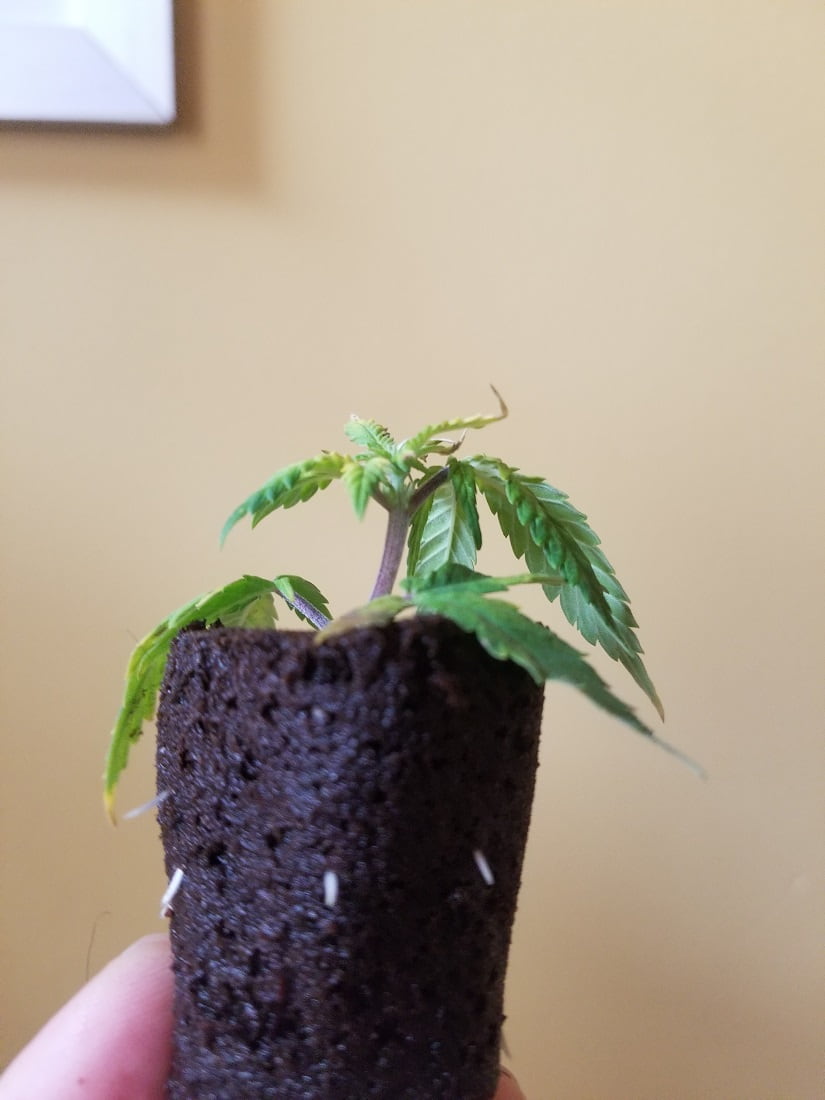
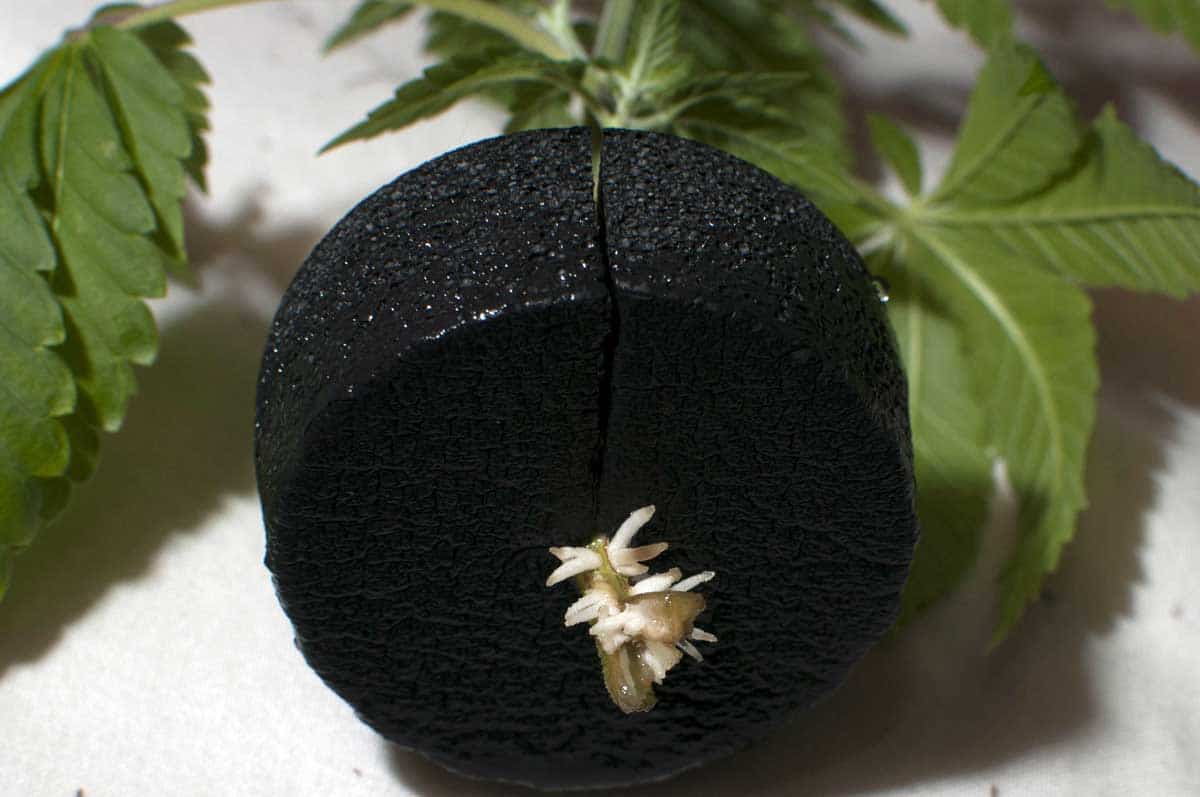
What Size of Pot for Clones?
The best pot size for cannabis clones after the initial rooting medium would be a 1 gallon container - ideally made out of fabric to allow for natural air pruning. Although it is possible to transplant the clone directly into it's permanent and larger container, it would benefit from a smaller temporary home.
When a plant has reached the edge of it's container, instead of elongating the roots, it will begin to increase the thickness of the rootball which later will readily absorb nutrients being added to the soil from your watering. By using a smaller 1 gallon pot, we can achieve this effect.
However, it is important to be considerate of how long you leave your new clone inside of the 1 gallon container. Around three weeks after being placed into the container, you will see a sudden upward growth, and thickening of the stem, which is the indicator that the plant has reached the edges of the pot. If it is not transplanted in a timely manner, the plant will become rootbound, and experience stunted growth among other more serious concerns such as root rot. When transplanting your marijuana clone, it should always be moved into a container which is at least three times larger than the last - otherwise the transition may not be worth the stress imposed on the plant.
Learn How to Clone Marijuana Plants
In summary, there are a number of techniques which can be used and considerations to make. Learning how to clone marijuana plants within their ideal environment - or at least the best one which you can offer them - will allow your clones the highest chance of forming roots and surviving, as well as reduce the time required for your clones to root. Experiement with the marijuana strain which you will be cloning and observing how it reacts while experimenting with the topics we discussed in this cloning guide.
Did we overlook something relating to marijuana cloning? You can share your experiences, tips and tricks, or ask your own questions in the comment section below!
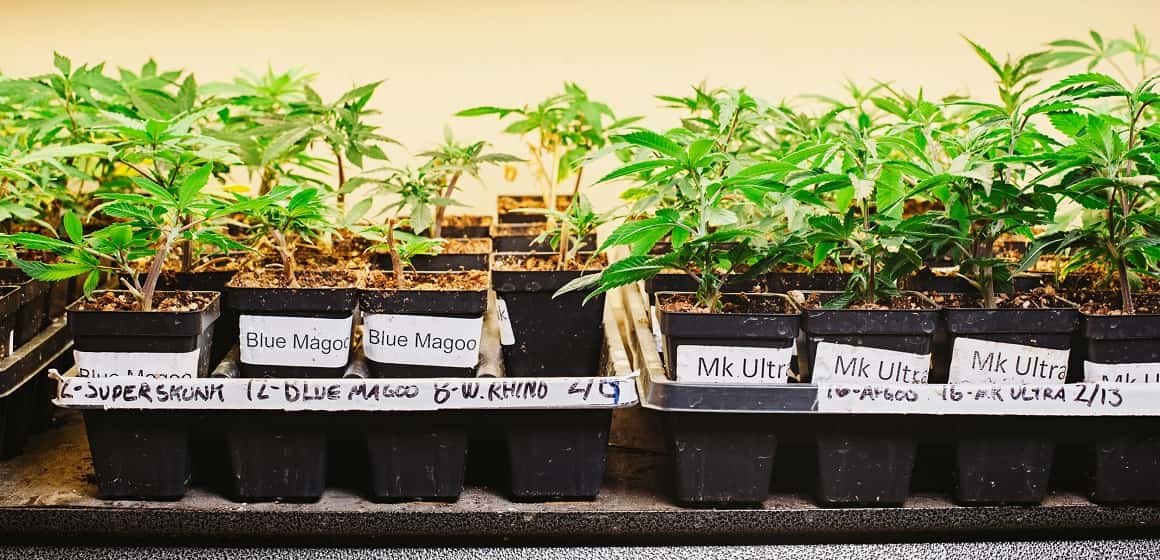

Marijuana Cloning FAQ - Become an Expert Discussions and Comments
Have something to say about this? Use the area below to discuss with the community!